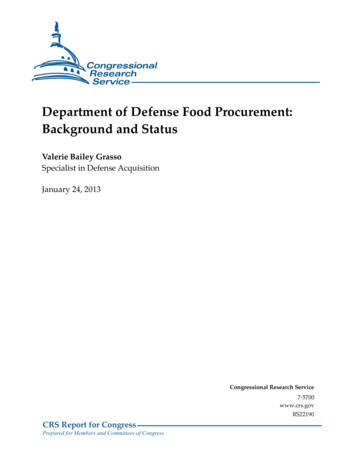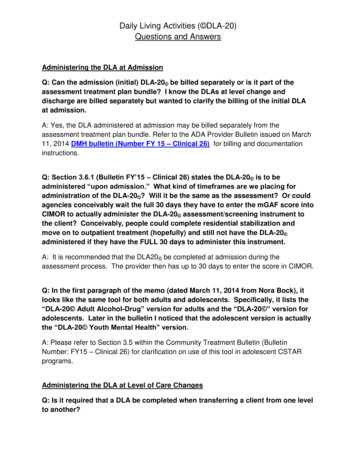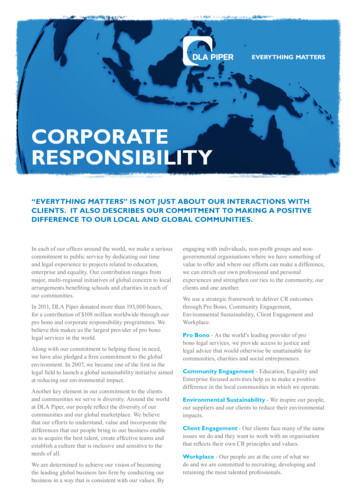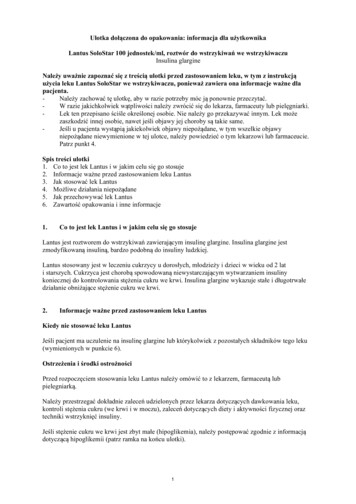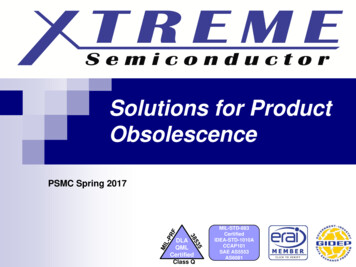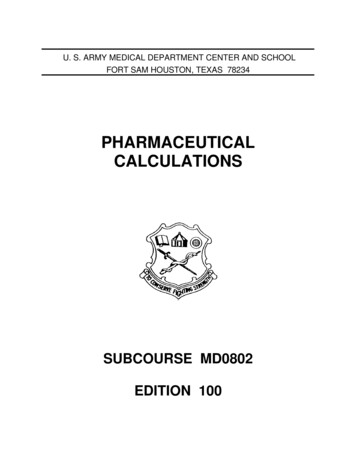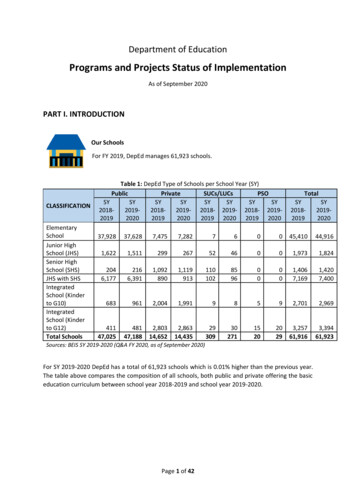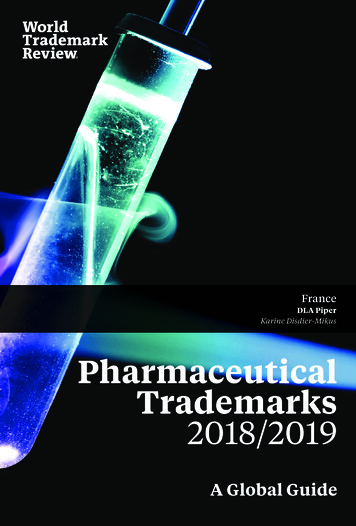
Transcription
FranceDLA PiperKarine Disdier-MikusPharmaceuticalTrademarks2018/2019A Global Guide
DLA PIPER ANDTRADEMARKSOur trademark practice is one of the best in the worldDLA Piper has a unique market offering for trademark matters,with a global trademark platform across multiple jurisdictions, anda truly industry focus.In Paris, we have a team of highly-skilled lawyers, formerly Europeanintellectual property lawyers, specialized in intellectual propertylaw, trademark management and prosecution, related disputes, aswell as any related matters concerning designs and domain names.The Paris trademark team is part of DLA Piper dedicated life-scienceteam comprising a range of skill sets and practitioners includinglawyers, and law professors, all of whom work in close collaborationwith experts from the various DLA Piper offices across the globe.With a focus on providing strategic, business-oriented advice, our teammembers essentially become extensions of our client’s business with athorough understanding of their businesses and industries.Contact us: trademark paris@dlapiper.comwww.dlapiper.comDLA Piper 27 rue Laffitte 75009 ParisT 33 (0)1 40 15 24 00 F 33 (0)1 40 15 24 01DLA Piper is a global law firm operating through variousseparate and distinct legal entities.Further details of these entities can be found at www.dlapiper.com
FranceDLA PiperAuthorKarine Disdier-MikusSelection, clearance and registrationLike all trademarks, pharmaceuticaltrademarks are subject to general trademarkrules regarding validity and use.Until recently, both French and Europeanlaw required a trademark to be capable ofgraphical representation. This requirementallowed the registration of shapes, coloursand sounds, but excluded signs such assmells. The European trademark law reform,comprising EU Directive 2015/2436 and theEU Trademark Regulation (2017/1001), deletedthe graphical representation requirementfrom trademark law. This change marks adramatic step forward in trademark law andcould make it easier to register smells andother non-traditional trademarks.A trademark must be capable ofdistinguishing the goods or services of oneundertaking from those of others. It serves asa guarantee of origin for the goods or servicesat hand. In this regard, the shapes of productshave been the subject of heated debate. For ashape to be registered as a trademark, it mustnot be determined solely by the nature orfunction of the product in question. Further,www.WorldTrademarkReview.comit must not give substantial value to the goods.In practice, many shape marks fall within oneof the excluded categories – especially in thefield of pharmaceutical products, in which notrademark application representing the shapeof a product has yet been considered valid.In any case, under Article L5121-10-3 ofthe Public Health Code, the holder of IP rightsin the shape or texture of a pharmaceuticalproduct cannot prohibit the use of anidentical or similar shape for a genericproduct. EU law provides no such exception.A pharmaceutical trademark must bedistinctive. Therefore, a descriptive or genericmark will not be considered valid. The lawalso specifically excludes certain marks andprovides that marks that are misleadingor contrary to public policy cannot beconsidered valid.In addition to these absolute grounds forrefusal, the trademark must not infringe priorrights. The prior rights listed in Article L711-4of the IP Code, and supplemented by case law,include: trademarks; company names;Pharmaceutical Trademarks 2018/2019 32
FRANCE DLA PIPERtrade names and shop signs;designations of origin;copyrights;designs;names or images or persons or personalityrights;the names, images or reputations ofterritorial collectivities; anddomain names, provided that the websitein question:is operational before the application;andapplies to the same or a similar fieldof activity.The registration of a pharmaceuticaltrademark must not create a risk of confusionwith any of the prior rights listed above.The risk of confusion must be assessed inconsideration of the relevant public, usuallycomprising medical professionals andpatients (European Court of Justice (ECJ),Alcon v OHMI-Biofarma, C-412/05, April 262007; General Court, Ferring v OHIM – TillottsPharma (OCTASA)T‑502/12, April 9 2014). Therisk of confusion must take into account theweak distinctive character of the elementsthat comprise pharmaceutical trademarks,which is due to the fact that they usually refereither to the active components of the productor to the area of treatment (March 30 2011;Court of Cassation, Commercial Chamber,Laboratoires Brothier v Ipsen Pharma,10-18141, April 27 2011; Paris Court of Appeal,2014/03379, June 18 2015).For example, in the field of allergytreatments, the prefix ‘Allerg-’ is commonlyused in France. Case law tends to take thisreality into account, concentrating on theother elements while disregarding theidentical but common use of these prefixes(Paris Court of Appeal, Allergan v Directeur del’INPI & Sté Santé Nature Distribution).After five years, a trademark may besubject to revocation for non-use. Thetrademark owner must therefore provethat it is exploiting the trademark forall goods and services designated in theregistration. European and French case lawconsider the category of ‘pharmaceuticalpreparations’ to be sufficiently broad todivide into sub-categories, each of which is33 Pharmaceutical Trademarks 2018/2019considered autonomously (General Court,GlaxoSmithKline v OHIM; T-493/07, T-26/08and T-27/08, September 23 2009; Paris CivilCourt, 11/16569, January 10 2014). Therefore,if a trademark owner is exploiting products inone sub-category only, it may not be deemedto have exploited products for the entirecategory of pharmaceutical preparations.Regulatory approvalsIn order for a pharmaceutical trademark tobe registered, no prior authorisation is neededper se. Unlike in other countries, in Francethe trademark owner is independent fromthe party exploiting the trademarkand need not possess a particular quality(eg, be a pharmacist or be authorised to sellthe product).However, prior authorisation is required inorder to exploit a pharmaceutical trademark;in practice, this is often sought at the sametime as the trademark application is filed.Authorisation can be issued by the EuropeanMedicines Agency (EMA) or the AgenceNationale de Sécurité du Médicament et desProduits de Santé (ANSM). A delay in theissue of this authorisation may constitute alegitimate excuse for the trademark ownernot exploiting the trademark within five years(Paris Court of Appeal, 89/023824, November12 1991).Confusion with INNsThe aim of international non-proprietarynames (INNs) is to facilitate the identificationof pharmaceutical substances and activepharmaceutical ingredients. Each INN isa unique name that is globally recognisedand is public property. It is also known as ageneric name.Article R5121-2 of the Public Health Codeprovides that a pharmaceutical trademarkmust not create a risk of confusion with anINN. This requirement is taken into accountby national and European trademark offices,which consider whether an applied-fortrademark is likely to be confused with anINN during the examination process. Shouldthis be the case, the trademark applicationwill be rejected.Even if the trademark application isaccepted by the relevant trademark office,www.WorldTrademarkReview.com
DLA PIPERthere remains the risk of cancellation by acourt should it identify possible confusionbetween the trademark and an INN (LyonCourt of Appeal, Merial v Virbac, 13/08055,May 13 2015).Parallel imports and repackagingParallel imports within the European Unionare governed by the rule of exhaustionof rights, which provides that once atrademarked product has been offeredfor sale on the European market by thetrademark owner or with its consent, theproduct may freely circulate within themarket. There is no exception to this rule forpharmaceutical products.However, the issue of repackaging isimportant for pharmaceutical products.Indeed, since the sale of such products isstrictly regulated, packaging requirementsdiffer between countries (as exemplifiedby the issue of translation of instructionson packaging).The courts have considered this issue andhave held that, in principle, the trademarkowner has a right to oppose the repackaging ofits products. However, the right of oppositionyields in certain circumstances. The followingconditions must be met, set out in BristolMyers Squibb (C-427/93, C-429/93 andC-436/93, July 11 1996) and further interpretedin Boehringer Ingelheim (C-348/04, April6 2007): The repackaging must be necessary topermit imports; The repackaging must not:adversely affect the original conditionof the product; ordamage the reputation of thetrademark or its owner; The repackaging must indicate the names of:the party by which the product hasbeen repackaged; andthe manufacturer of the product; and Prior notice must be given to thetrademark owner.The importer has the burden of provingcompliance with all conditions. Should it failto do so, the rights holder will have the rightto oppose import. However, should it provecompliance, the onus will rest with the rightswww.WorldTrademarkReview.comFRANCEholder to prove otherwise.Regarding packaging, the EU FalsifiedMedicines Directive (2011/62/EC) providesnew control measures for preventing thedistribution of falsified pharmaceuticalproducts. Member states have transposedthe directive into national law and hadto implement the new control measuresby 2017. These include tracking measuresbased on the serialisation of products andcover all pharmaceutical products subject toprescription. In France, the directive has beenapplicable since July 1 2017 (Ordinances 20161729 and n 2012-1427 and Decree 2012-1562).Anti-counterfeiting and enforcementTrademark infringement is punishable byboth civil and criminal penalties. The aimis to fight infringements more efficiently bystrengthening the powers and resourcesof Customs.Customs measuresIn its most recent reports, Customs statedthat the number of goods seized for IPinfringement has increased dramatically. Thistrend is not apparent in the pharmaceuticalsector, however: while in 2014 Customs seizedtwice as many pharmaceutical products(2,580,793) as it had in 2013 (1,354,705), thenumber of pharmaceutical products seized in2016 dropped significantly, to 189,539.This is partly due to the implementationof Law 2014-315, which strengthened themeasures available to Customs to fight IPinfringement by aligning French law with EUprovisions. These measures include: a simplified new procedure for thedestruction of illegal products; a longer timeframe for the rights holder torequest customs intervention; and the extension of retention measures to IPrights other than trademarks.According to French law, these measurescan also be taken on Customs’ own initiative,without a request by the rights holder (ArticleL716-8-1 of the IP Code).Transit: new solutionsArticle 11 of the EU Trademark Regulationand Article 10(4) of EU Directive 2015/2436Pharmaceutical Trademarks 2018/2019 34
FRANCEDLA PIPERprovide that Customs can seize infringingproducts that are in transit and have not beenintroduced on the European market. In orderto oppose the seizure, the holder of the goodsmust prove that the rights holder has no rightto prevent their commercialisation in thecountry of final destination. These provisionswill increase the volume of goods seized byCustoms and assist trademark owners infighting infringement.At present, this solution applies only to EUtrademarks. The directive must be transposedinto French law before it can apply to Frenchtrademarks. ECJ case law will be significantlymodified as a result and it is expected thatsimilar solutions will be extended to other IPrights in the future.AdvertisingAdvertising of pharmaceutical products thattargets the general public is strictly regulatedby the Public Health Code.Only certain products can be advertised.Several conditions must be met: The product must not:require a medical prescription; orbe reimbursed by mandatory healthinsurance schemes; and The marketing authorisation must notinclude any prohibition against advertisingto the general public due to public healthrisks (eg, where the product is not suitablewithout medical intervention). Karine comKarine Disdier-Mikus is a partner in DLAPiper’s IP and technology department in Paris.She heads the IP practice. She has a master’sdegree from a French university and an LLMfrom McGill University, Canada. She is a formerEuropean trademark and design attorneyand has more than 15 years’ experiencein trademark and design prosecution andlitigation, brand protection, anti-counterfeitingand brand enforcement, especially in thepharmaceutical and life sciences sectors. Shehas also developed significant expertise indomains, Uniform Domain Name DisputeResolution Policy proceedings and new generictop-level domains. She is an active member ofthe International Trademark Association andthe Association of Trademark and Design LawPractitioners.35 Pharmaceutical Trademarks 2018/2019 Ads for pharmaceutical products may not:state that:medical consultation is unnecessary;the product is guaranteed to have therelevant effects, can be used withoutside effects or is better than anothertreatment; orgood health might be improved by useor adversely affected by non-use;liken the product to food products orcosmetics;play on fear in a major sense or mislead inany way; ortarget children only.Regarding products that are subject tomedical prescription, advertising may betargeted at health professionals only.In recent years, comparative advertisinghas become an issue. Comparative advertisingis permitted under French law, providedthat it objectively compares characteristicsthat are essential, relevant, verifiable andrepresentative of the relevant goods orservices. Comparative advertising canmention a trademark in order to identify theproducts with which the comparison is beingmade. Given the above limits imposed on theadvertising of pharmaceuticals, comparativeadvertising in this field is minimal.The courts considered whether itis possible to mention the name of atrademarked pharmaceutical product whenwww.WorldTrademarkReview.com
DLA PIPERFRANCEadvertising the generic version of thatproduct. The Supreme Court held that thepresentation of a product as the genericversion of a trademarked productis considered legitimate comparativeadvertising (Sandiz v Beecham Group,09-70.722, May 24 2011). Generic substitutionArticle L5125-23 of the Public Health Codeprovides that pharmacists can substitute amedically prescribed trademarked productwith a generic version that fulfils therelevant conditions (eg, bioequivalence inaccordance with Article L5121-1 of the PublicHealth Code). However, the substitutionof a trademarked product with anothertrademarked product is prohibited andpunishable by three years’ imprisonmentand a 300,000 fine (Article L716-10 of the IPCode). This was upheld by the Supreme Courtin a case in which a pharmaceutical companypresented its product as generic even thoughit was an original trademarked product; thesubstitution was therefore unlawful (Mylan vIPSEN Pharma, 11-20.725, October 9 2012).Non-compliance with these conditionswill lead to penalties ranging from temporaryclosure of the website to an administrativefine. A list of authorised websites can befound on the Order of Pharmacists’ website.The general rules for advertising alsoapply to online advertising.Online issuesE-pharmaciesIn principle, pharmaceutical products can besold in pharmacies only (Article L4211-1 of thePublic Health Code). This provision is strictlyenforced and any violation is considered acriminal offence. However, in order to takeinto account the development of online salesof goods, the EU Falsified Medicines Directive(2011/62/EC), transposed into French law,provides that owners of pharmacies can sellcertain over-the-counter products online.Prescription-only products cannot besold online.Online sales of pharmaceutical productsare strictly regulated and are subject to thefollowing conditions: There must be a physical pharmacy behindthe website;www.WorldTrademarkReview.com The website must be managed by apharmacist;The pharmacist must obtain authorisationfrom the Regional Health Agency; andThe pharmacist must inform the Order ofPharmacists of his or her intention to sellpharmaceutical products online.Domain namesA pharmaceutical trademark can beregistered as a domain name. However,the ANSM sets out specific conditionsenforcing compliance of the correspondingwebsite with the rules on advertising. Forinstance, the ANSM explicitly providesthat if a website corresponds to a domainname which includes a pharmaceuticaltrademark designating a medicine or amedical device for which advertising to thegeneral public is prohibited, it must have asecure home page. WTRDLA Piper27 rue LaffitteParis 75009FranceTel 33 1 40 15 24 00Fax 33 1 40 15 24 01Webwww.dlapiper.comPharmaceutical Trademarks 2018/2019 36
DLA PIPER AND TRADEMARKS Our trademark practice is one of the best in the world DLA Piper is a global law firm operating through various separate and distinct legal entities. Further details of these entities can be found at www.dlapiper.com www.dlapiper.com DLA Piper has a unique market offering for trademark matters,
